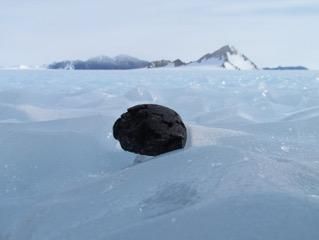Iron Meteorites Play Hide-and-Seek Under Antarctic Ice
Meteorites give scientists a glimpse into our early solar system, but the sun’s rays and melting ice may make these extraterestrial crumbs harder to find
/https://tf-cmsv2-smithsonianmag-media.s3.amazonaws.com/filer/c9/b1/c9b132b4-b2e6-4b81-8a0b-3fb5c77eec27/397663main_mountains_1600-1200.jpg)
Until researchers can hop a spaceship and travel to other planets, they must be content to study the inner workings of our solar system by examining the meteorites that fall to Earth.
Antarctica is a hotspot for these extraterrestrial crumbs, and almost every December, scientists from NASA and other space agencies trek to the continent in search of meteorites. They are particularly interested in the iron or stony-iron space rocks that can give them a glimpse into a planet's early development. But these prized iron-rich fragments are a lot harder to find than their stony counterparts.
Scientists believe the iron-rich rocks are sinking below the surface but no one exactly knows why. Now, a new study may have come up with a novel explanation.
Scientists find plenty of stony meteorites. The southern continent's snowy-white conditions make it an ideal place to spot these mostly golf-ball sized space rocks, with more than 34,927 collected so far. These chunks include bits from the Moon and even Mars.
But less than 1 percent of the meteorites researchers collect in Antarctica are of the iron or stony-iron variety, compared to around 5.5 percent in the rest of the world.
Once they hit Antarctica, meteorites typically get trapped in the ice but will eventually make their way to the surface, especially in hot spots near the LaPaz Ice field and Frontier Mountains that are referred to as meteorite stranding zones.
"The ice hits the Transantarctic Mountains and can’t reach the sea," says study co-author Geoffrey Evatt, a senior lecturer in Applied Mathematics at the University of Manchester. The ice gets deflected virtually upwards, he explains, which can bring the trapped meteorites to the surface.
But Evatt and his colleagues wondered why the iron meteorites weren’t going along for the ride.
Through modeling and laboratory experiments in which they studied iron meteorites in blocks of ice, they concluded that energy from the sun was heating them up and forcing the meteorites to slip back down into the ice, according to their study published recently in the journal Nature Communications.
"The stony meteorites don’t really conduct energy that well," says Evatt. "They absorb the heat from the sun, but it takes them a long time to pass the energy down towards the ice below them."

"But iron meteorites pick up energy from the sun and, rather like a frying pan, quickly transmits the energy to the bottom of it," he explains. "That can cause melting of the ice underneath the meteorite.”
If Evatt and his team are correct, they have come up with a road map of sorts for locating these meteorites—which probably number rabout 1 per every square kilometer (roughly 0.4 square miles) and are “tantalizing close” to the surface, from 4 to 16 inches down.
You could probably see them just below the surface of the ice if you were in the right spot, Evatt says. "It’s rather like seeing a rock hanging just below the surface of the water, looking into a shallow stream."
James Karner, a research scientist at Case Western Reserve University and co-principal investigator for the U.S.-led Antarctic Search for Meteorites, says the study proves what many had theorized but never actually investigated.
"We’ve always been a little worried that we are not getting a sampling of what is out there," says Karner, who was not involved in the study.
"This study is a great proof of principle that iron meteorites can sink in the ice and this could happen in Antarctica," he says. Karner and his team have spent the past eight years collecting meteorites in Antarctica. His team finds 300 to 1,000 pieces of meteorite each season.
Finding more of these iron meteorites, Evatt says, would give scientists a better idea of how early protoplanets formed.
"In the case of iron meteorites, these are the cores of small planets," Evatt explains. The early solar system contained lots of planets, more than what we have now. While most of the smaller bodies broke up or merged with other planets, a few grew large enough that they formed iron-based cores. So iron meteorites can tell you about how those planets formed, Evatt says.
Karner agreed, adding that those meteorites could tell us more about the asteroid belt and even what happened during Earth's early days.
The prospect of these meteors being so accessible has sparked Evatt and his team to write up a grant proposal for an expedition to find them. They would be the first British and European team to go in search of meteorites in Antarctica.
"It’s not a case where [the meteorites] sunk to the bottom of the Antarctic ice sheet," Evatt said. "They are there and it is feasible to go and find them. It will take quite a bit of effort but it is possible."
But Karner was less optimistic. "It would take a big change in the way we search for meteorites," he says, which currently involves visual identification by teams on snowmobiles or on foot crisscrossing the ice.
"With technology advancing, you never know," Karner says. "In the future, you might have some kind of ground penetrating radar that you could do with a drone or something and be able to pinpoint some of the meteors that they say are under the ice."
Learn more about this research and more at the Deep Carbon Observatory.